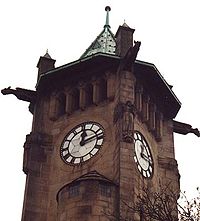Lindley, Huddersfield
This article needs additional citations for verification. (July 2013) |
| Lindley | |
|---|---|
 Lindley Clock Tower | |
Location within West Yorkshire | |
| OS grid reference | SE115185 |
| • London | 165 mi (266 km) SE |
| Metropolitan borough | |
| Metropolitan county | |
| Region | |
| Country | England |
| Sovereign state | United Kingdom |
| Post town | HUDDERSFIELD |
| Postcode district | HD3 |
| Dialling code | 01484 |
| Police | West Yorkshire |
| Fire | West Yorkshire |
| Ambulance | Yorkshire |
| UK Parliament | |
Lindley is a suburb of Huddersfield, within the metropolitan borough of Kirklees in West Yorkshire, England. It is approximately 2 miles (3 km) northwest from Huddersfield town centre.
The Huddersfield Royal Infirmary, Huddersfield's main hospital, is in Lindley. It is in the Central Huddersfield Primary Care Trust, part of the Calderdale and Huddersfield Trust. In 1951, the scheme for building the new Infirmary was announced, at an initial cost of £5.5 million. Work started in 1957, but progress was slow. The hospital was officially opened only in 1967, by Prime Minister Harold Wilson, born in Huddersfield.
History
The name for Lindley comes from the Saxon for "flax meadow" or possibly from the Germanic word 'lind' denoting an area of linden (or lime) trees.
Probably established by the Angles in the 7th century as a farming community, it is mentioned in the Domesday Book under the names "Lilleia". In the reign of Edward the Confessor it was owned by Godwin, and in the reign of William the Conqueror it was being cultivated by Ulchel for Ilbert de Lacy, the Sheriff of Hertfordshire and descendant of the French noble family from Lassy. At that time, Lindley consisted of two farmsteads totalling "5 quarantens by 2 quarantens".
The Lindley Clock Tower is the most prominent landmark in Lindley,[1] standing at the junction between Lidget Street and Daisy Lea Lane. This Art Nouveau clock tower was designed by the Manchester architect Edgar Wood in 1900 and erected by James Nield Sykes JP, in 1902. The tower also features four buttress figures, four gargoyles and four friezes. The top of the tower is accessible via the doorway at its foot.
Another key building in Lindley is Lindley Liberal Club, situated adjacent to Lindley Clock Tower. The Club has been in existence since its foundation stone was laid on 9 August 1887. The club came into use when building was completed the following year. This building is actually older than the Clock Tower, which was commissioned in 1902.
Lindley appeared top in a survey carried out in 2006 by the Royal Bank of Scotland. By creating an algorithm factoring aspects such as desirability, return on investment and affordability, the survey results listed the top 10 locations throughout the UK for first time buyers to get on the property ladder.
Band
Lindley Band was formed in the late 1830s and has been a major band in Huddersfield for most of its history.[citation needed] It was one of the leading bands in the UK from 1880 to 1910. The band were featured in a 2008 episode of Life on Mars and also appeared in a 1950s film called Asylum. It is currently in the first section.[clarification needed]
Schools
Lindley Junior and Infants School is situated on George Street next to a housing estate. It caters for age group 4 to 11, with an enrolment of approximately 500 pupils. Lindley Junior School won the Songs Of Praise School Choir of The Year competition in 2008 and 2016.They have appeared on Look North, and have previously taken first place in the local Mrs Sunderland Music Competition.
References
Further reading
- Brook, Roy (1968): The Story of Huddersfield. ISBN 0-261-61983-7

